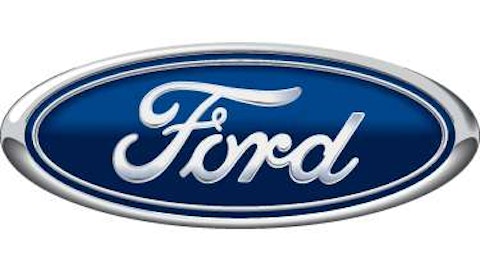Last year, Geely Automobile Holdings‘ Volvo launched its first-ever V60 diesel plug-in hybrid, and this year, its popularity has skyrocketed. So far, it’s sold out across Europe, was one of three finalists for the 2013 Green Car of the Year award, and was Volvo’s most popular new car launch, ever. What’s more, this success may pave the way for an American launch of a Volvo plug-in. Here’s what else you need to know.

Source: Wikimedia Commons.
The V60 Plug-In Hybrid
In 2010, Ford Motor Company (NYSE:F) sold Volvo to Geely, and things didn’t look promising for Volvo — especially after the 2011 reveal of the Universal Concept. But after the successful launch of the V60 Plug-In Hybrid, or PHEV, that outlook may be changing.
Starting at $74,000 — before U.K. incentives — the V60 PHEV can go 31 miles per electric charge, before switching to a 212 HP, 2.4 turbodiesel engine, with 324 pound-feet of torque. Weighing just over 4,400 pounds, the V60 PHEV can go from 0 to 60 in 5.8 seconds, has a top speed of 143 mph while running on gas, and can hit 78 mph when running on all-electric.
The battery that powers the V60 PHEV is an 11.2 kWh lithium-ion battery, but it uses only 8 kWh. Further, Volvo states that under Europe’s New European Driving Cycle, the official fuel economy figure is 155.2 mpg. The car also has AWD, a five-star crash rating, a full SE Lux specification, and the ability to drive in three different modes: Pure (all electric), Hybrid, and, Power (all diesel). And it can seat five and with plenty of room left for storage.
Sales are sky-high
The initial V60 PHEV launch was for 1,000 cars, and they sold out before hitting the showroom. Then the V60 PHEV qualified for the U.K. plug-in grant, which brought the price to around $65,000. That caused Volvo to raise production to 4,000-6,000 for 2013. But sales have been so strong that Volvo said it might raise production to 10,000.
Volvo had been slow to release a “green car,” citing lack of demand, and the V60 isn’t available in the United States. However, the success of the V60 PHEV may be enough to change Volvo’s mind. And even if Volvo doesn’t bring this car to America, there are a number of concept models, such as the XC60 PHEV SUV, that Volvo sees as marketable in the U.S. and China. Considering the U.S. and China are the two biggest names when it comes to automotive sales, a hot-selling PHEV would be great for Volvo.
Volvo’s future
Volvo has already shown that its V60 PHEV is a powerful force in the sales department, so if the company decides to release it in the U.S., or introduce a different PHEV, it will be something to watch.
Electric vehicles have been slowly gaining in popularity — whether it’s a PHEV, a BEV, or any other variation. But sales for EVs are still low and make up only a limited market share. Consequently, any new EV release will probably affect other EV sales. Here’s an example: At the beginning of 2012, there were really only three comparable EVs available — General Motors Company (NYSE:GM)‘ Chevy Volt, Toyota Motor Corporation (ADR) (NYSE:TM)‘s Prius Plug-In Hybrid, and Nissan Motor Co., Ltd. (ADR) (OTCBB:NSANY)‘s Leaf.

Source: Inside EVs‘ Monthly Plug-In Sales Scorecard,
Overall, the Prius Plug-In sold relatively well — in fact, it was the second best-selling plug-in. But in May, Ford Motor Company (NYSE:F) saw its first sales of the Focus Electric, and that was followed by more EV releases. By 2013 there were a number of EVs available — and Toyota Motor Corporation (ADR) (NYSE:TM) saw a steady decline in sales.

Source: Inside EVs‘ Monthly Plug-In Sales Scorecard,
As 2013 has progressed, more EVs — such as the Chevy Spark — have become available, and the Volt and Leaf have struggled, while sales of other EVs have climbed. Thanks to the limited market, having more EVs come to market dilutes other EV sales.
The V60 PHEV is a luxury hybrid, and it’s already competing with Tesla Motors Inc (NASDAQ:TSLA)‘ Model S for European sales — the 40 kWh isn’t available outside the U.S, and the 60 kWh Model S starts around $91,000 outside the United States. If the V60 PHEV comes to America, it’ll compete with Tesla in the luxury EV market. And if Volvo decides to release XC60 PHEV SUV, it could compete with Tesla’s Model X.
What to watch
Right now, sales for the V60 PHEV are incredibly strong and seem to be getting stronger. That makes it a game-changer for Volvo. However, Volvo’s production of the V60 PHEV is limited, and it’s a diesel, so It may not make it to the U.S anytime soon — although there are rumors to the contrary. If the V60 PHEV does come to the U.S., this is a vehicle to watch — not only for what it can do for Volvo’s profits, but also for how it could affect other EVs’, and in particular Tesla Motors Inc (NASDAQ:TSLA)’s, sales.
The article Volvo’s New Plug-In Hybrid Is a Game-Changer originally appeared on Fool.com and is written by Katie Spence.
Fool contributor Katie Spence has no position in any stocks mentioned. Follow her on Twitter: @TMFKSpence. The Motley Fool recommends Ford, General Motors, and Tesla Motors and owns shares of Ford and Tesla Motors.
Copyright © 1995 – 2013 The Motley Fool, LLC. All rights reserved. The Motley Fool has a disclosure policy.




